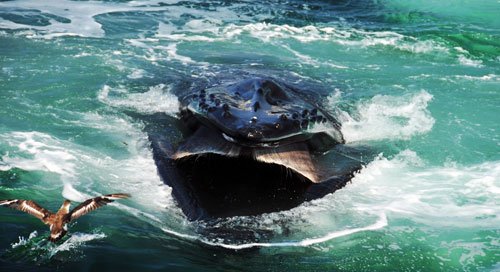Ancient whale sucked up prey vacuum cleaner-style

THE FOSSILISED JAW of a 25-million-year-old baleen whale is shedding light on how the mouths of Earth’s largest ever animals evolved.
The 30cm fossil, found in the coastal town of Torquay, Victoria, shows the earliest of these marine mammals had vastly different feeding habits to its modern descendants. Museum Victoria palaeontologist Dr Erich Fitzgerald says that the jaw of this early whale, Janjucetus hunderi, shows that ancient baleen whales didn’t have the flexibility to gulp and filter enormous volumes of seawater and krill, as living baleen whales do.
Janjucetus was a relatively small species and was likely no longer than 3m in length, says Erich.
Filter-feeding not distinguishing feature of baleen whales
In a paper published today in the journal Biology Letters, he argues the Janjucetus‘ rigid lower jaw joints and wide mouth were better suited to sucking up individual prey in the fashion of a vacuum cleaner.
“These new fossils are really the clincher in showing that they could not filter feed,” Erich says. “Many scientists have argued that filter-feeding is really one of the key distinguishing features of all baleen whales. Now it seems that is not the case, and that it evolved later.”
He says ‘suction-feeding’ was most likely an evolutionary precursor to the filter-style of feeding that baleen species such as the humpback whale and blue whale are known for today. A huge mouth, loose lower jaw and baleen (a hair-like structure inside the mouth that serves as a sieve) are vital for species such as the blue whale to be able to strain sea water and consume as much as 3000kg of krill per day.
The first baleen whales had a wide upper jaw, but they didn’t have baleen. Erich argues that while this huge mouth may have evolved millions of years ago, it wasn’t necessarily part of the evolutionary trend towards adapting to filter-feeding. Rather, it allowed early baleen whales to hoover up prey such as squid, large fish, sharks or even penguins, into their mouths.

A blue whale, perhaps the largest creature to have ever lived, takes in a vast mouthful of seawater and krill which it will filter with its baleen plates. (Credit: Rishi Menon)
Discovery provides insight into evolution of baleen whales
The flexible, elastic jaw, he says, came later. “This discovery shows us that the anatomical toolkit of modern baleen whales evolved first in the cranium (upper jaw), and that lower jaw evolution lagged behind,” he says.
Dr Steve Salisbury, palaeontologist at the University of Queensland in Brisbane, says the research fills an important gap in knowledge about the origins of this whale group. “Baleen whales with mobile jaws didn’t just appear one day,” he says. “All the features that have allowed them to feed the way they do, were acquired gradually, and one of those features – the mobile jaw – didn’t appear with the first [baleen] whales.”
Steve says that the suction style of feeding is used by many marine mammals, including dolphins and seals.
The mystery, according to Erich, is how and why baleen whales shifted from suction-feeding to filter-feeding. “That’s where the fossil trail goes cold, that’s really the next major phase of the evolution of baleen whales that needs to be uncovered,” he says. “All we can do at this stage is speculate.”
One possibility, he says, is that early baleen whales were suction feeding from the sea floor, drawing mud and sediment into their mouth along with their prey. In that case, “it would have been advantageous to filter out prey from that slurry of water and mud.”
RELATED STORIES




